- Home
- About Us
- Industry
- Services
- Reading
- Contact Us
Wet Wipes Market: Current Analysis and Forecast (2023-2030)
Emphasis on Decomposability (Biodegradable Wipes and Non-Biodegradable Wipes); Material Type (Woven and Non-woven); Application (Domestic, Industrial, and Others); and Region/Country
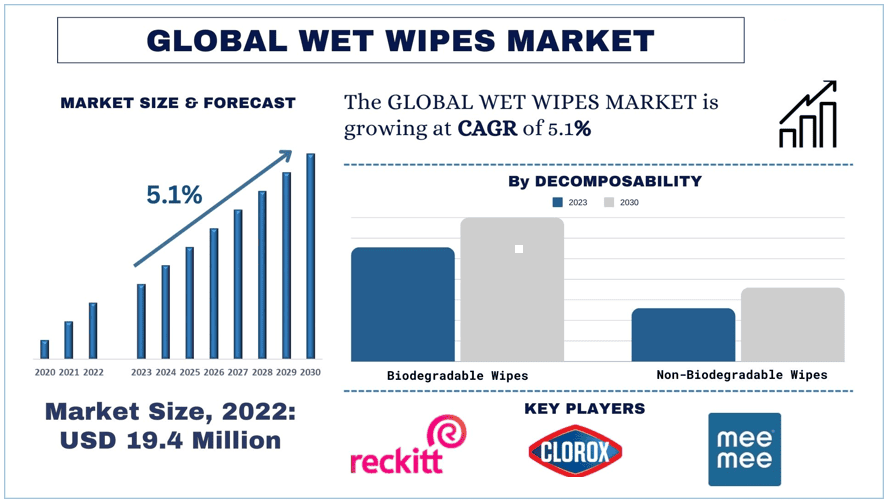
Wet Wipes Market Size & Forecast
The Wet Wipes Market was valued at USD 19.4 Million in 2022 and is expected to grow at a strong CAGR of around 5.1% during the forecast period (2023-2030) owing to the rising product innovations in wet wipes.
Wet Wipes Market Analysis
The Wet Wipes Market is escalating due to several reasons including the rising trend of sanitary practices, rise in research & development activities, rising strategic collaborations, and increasing adaptation of sustainable products. The enlarged product portfolio in the wet wipes section for multiple purposes is also driving the market’s growth.
According to the World Bank, hygiene promotion is the most cost-effective health action to reduce disease.
In September 2022, the India-based multi-locational company Ginni Filaments Ltd, commenced production at its new state-of-the-art wet wipe facility in India. The new facility is the largest wet wipes manufacturing facility in India with capabilities for alcohol, pharma, and cosmetic wipes. Such company initiatives are driving the growth of the market during the forecast period.
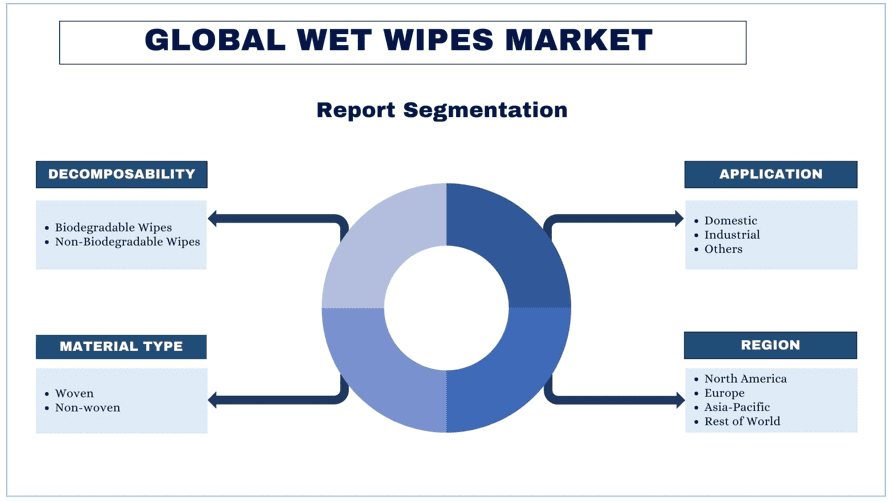
Wet Wipes Market Trends
This section discusses the key market trends that are influencing the various segments of the Wet Wipes Market as identified by our team of research experts.
Industrial Segment Transforming Industry Standards
The usage of wet wipes has expanded beyond personal hygiene and household cleaning to encompass various industries, contributing to significant growth in these sectors. Wet wipes are widely used in healthcare settings for patient care, surface disinfection, and medical equipment cleaning. They offer convenience, portability, and effectiveness in maintaining hygiene standards, reducing the risk of cross-contamination and healthcare-associated infections. In the food service and hospitality industries, wet wipes are used for sanitizing surfaces, cleaning dining areas, and maintaining food hygiene standards. Wet wipes play a crucial role in manufacturing and industrial settings for cleaning machinery, tools, and work surfaces. They help remove grease, oil, and contaminants, improving operational efficiency and maintaining workplace safety standards. The manufacturing industry’s adoption of wet wipes is driven by the need for cost-effective cleaning solutions and compliance with industry regulations. In the automotive industry, wet wipes are used for cleaning vehicle interiors, and removing dirt, stains, and spills from upholstery, dashboards, and surfaces.
Overall, the usage of wet wipes in industries continues to grow as businesses recognize the benefits of these versatile cleaning solutions in maintaining hygiene standards, improving operational efficiency, and enhancing customer satisfaction. With ongoing innovation, product development, and market expansion efforts, the demand for wet wipes across industries is expected to remain strong in the foreseeable future. Ongoing product innovations further propel the growth of these devices in the market. For instance, in April 2024, Berry Global Group got a grant for nonwoven fabric with blended fibers with additional features such as the inclusion of a liquid additive, the use of biopolymers like polylactic acid, and the potential application of the fabric as wipes with antimicrobial properties.
North America is Expected to Grow with Significant CAGR During Forecast Period
Within North America, the U.S. holds a major share of the market. The major factors boosting the market’s growth in the country are the increasing number of awareness programs for sanitation, rising product innovations, growing research and development activities, a well-established consumer goods infrastructure, and the presence of several market players.
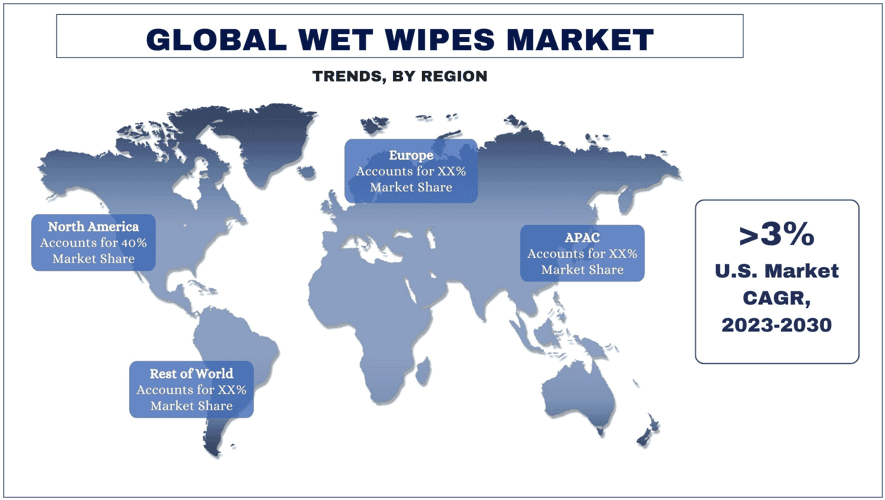
According to the World Health Organization, in 2022, 57% of the global population, i.e., 4.6 billion people, used a safely managed sanitation service.
In November 2021, U.S.-based company Edgewell Personal Care Company acquired Billie Inc., a leading U.S.-based consumer brand company that offers a broad portfolio of personal care products including wet wipes.
Wet Wipes Industry Overview
The Wet Wipes Market is competitive, with the presence of several global and international market players. The key players are adopting different growth strategies to enhance their market presence, such as partnerships, agreements, collaborations, new product launches, geographical expansions, and mergers and acquisitions. Some of the major players operating in the market are Procter & Gamble; Johnson & Johnson Private Limited; Kimberly-Clark Worldwide, Inc; Reckitt Benckiser; Rockline Industries; The Clorox Company; Nice-Pak Products, Inc.; MEEMEE.IN; Himalaya Wellness Company; Honasa Consumer Limited.
Wet Wipes Market News
In December 2023, Albaad, a globally recognized manufacturer and marketer of wet wipes and nonwovens, took an ambitious stand against the detrimental impact of traditional wet wipes on the environment by setting its sights on producing high-quality, sustainable solutions that prioritize both people’s well-being and the planet.
In December 2023, Lenzing launched an upgraded Veocel shortcut lyocell fibers for the flushable wipes market which have higher dispersibility and benefit from a new finish that improves processability and enhances the efficiency of their production process.
In November 2023, a company Hancost Prim specializing in the manufacture of wet wipes benefited from a grant worth 30,000 euros from the European Union and United Nations Development Programme Moldova.
In February 2022, Essity, a leading global hygiene and health company, acquired Legacy Converting, Inc., a U.S.-based cleaning and wiping company and manufacturer of the best-in-class, EPA-regulated Everwipe brand of disinfecting and wiping products.
Wet Wipes Market Report Coverage
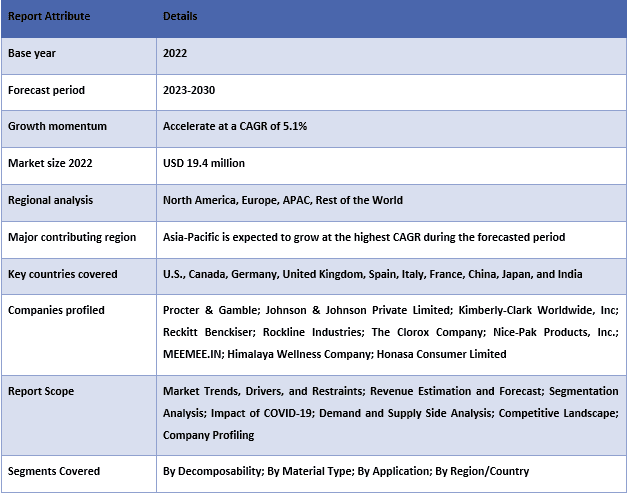
Reasons to buy this report:
- The study includes market sizing and forecasting analysis validated by authenticated key industry experts.
- The report presents a quick review of overall industry performance at one glance.
- The report covers an in-depth analysis of prominent industry peers with a primary focus on key business financials, product portfolios, expansion strategies, and recent developments.
- Detailed examination of drivers, restraints, key trends, and opportunities prevailing in the industry.
- The study comprehensively covers the market across different segments.
- Deep dive regional level analysis of the industry.
Customization Options:
The global Wet Wipes Market can further be customized as per the requirement or any other market segment. Besides this, UMI understands that you may have your own business needs, hence feel free to connect with us to get a report that completely suits your requirements.

You can also purchase parts of this report. Do you want to check out a section wise
price list?
Table of Content
Research Methodology for the Wet Wipes Market Analysis (2023-2030)
Analyzing the historical market, estimating the current market, and forecasting the future market of the global wet wipes market were the three major steps undertaken to create and analyze the adoption of wet wipes in major regions globally. Exhaustive secondary research was conducted to collect the historical market numbers and estimate the current market size. Secondly, to validate these insights, numerous findings and assumptions were taken into consideration. Moreover, exhaustive primary interviews were also conducted, with industry experts across the value chain of the global wet wipes market. Post assumption and validation of market numbers through primary interviews, we employed a top-down/bottom-up approach to forecasting the complete market size. Thereafter, market breakdown and data triangulation methods were adopted to estimate and analyze the market size of segments and sub-segments of the industry pertains to. Detailed methodology is explained below:
Analysis of Historical Market Size
Step 1: In-Depth Study of Secondary Sources:
Detail secondary study was conducted to obtain the historical market size of the wet wipes market through company internal sources such as annual reports & financial statements, performance presentations, press releases, etc., and external sources including journals, news & articles, government publications, competitor publications, sector reports, third-party database, and other credible publications.
Step 2: Market Segmentation:
After obtaining the historical market size of the wet wipes market, we conducted a detailed secondary analysis to gather historical market insights and share for different segments & sub-segments for major regions. Major segments are included in the report as decomposability, material type, application, and region. Further country-level analyses were conducted to evaluate the overall adoption of testing models in that region.
Step 3: Factor Analysis:
After acquiring the historical market size of different segments and sub-segments, we conducted a detailed factor analysis to estimate the current market size of the wet wipes market. Further, we conducted factor analysis using dependent and independent variables such as decomposability, material type, application, and region of the wet wipes market. A thorough analysis was conducted for demand and supply-side scenarios considering top partnerships, mergers and acquisitions, business expansion, and product launches in the wet wipes market sector across the globe.
Current Market Size Estimate & Forecast
Current Market Sizing: Based on actionable insights from the above 3 steps, we arrived at the current market size, key players in the global wet wipes market, and market shares of the segments. All the required percentage shares split, and market breakdowns were determined using the above-mentioned secondary approach and were verified through primary interviews.
Estimation & Forecasting: For market estimation and forecast, weights were assigned to different factors including drivers & trends, restraints, and opportunities available for the stakeholders. After analyzing these factors, relevant forecasting techniques i.e., the top-down/bottom-up approach were applied to arrive at the market forecast for 2030 for different segments and sub-segments across the major markets globally. The research methodology adopted to estimate the market size encompasses:
- The industry’s market size, in terms of revenue (USD) and the adoption rate of the wet wipes market across the major markets domestically
- All percentage shares, splits, and breakdowns of market segments and sub-segments
- Key players in the global wet wipes market in terms of products offered. Also, the growth strategies adopted by these players to compete in the fast-growing market
Market Size and Share Validation
Primary Research: In-depth interviews were conducted with the Key Opinion Leaders (KOLs) including Top Level Executives (CXO/VPs, Sales Head, Marketing Head, Operational Head, Regional Head, Country Head, etc.) across major regions. Primary research findings were then summarized, and statistical analysis was performed to prove the stated hypothesis. Inputs from primary research were consolidated with secondary findings, hence turning information into actionable insights.
Split of Primary Participants in Different Regions
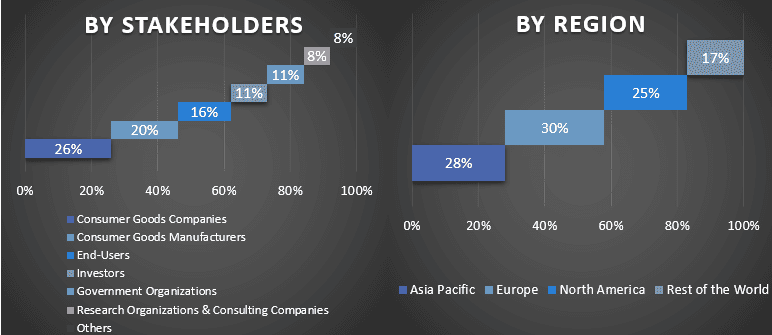
Market Engineering
The data triangulation technique was employed to complete the overall market estimation and to arrive at precise statistical numbers for each segment and sub-segment of the global wet wipes market. data was split into several segments & sub-segments post studying various parameters and trends in the areas of the decomposability, material type, application, and region in the global wet wipes market.
The main objective of the Global Wet Wipes Market Study
The current & future market trends of the global wet wipes market were pinpointed in the study. Investors can gain strategic insights to base their discretion for investments on the qualitative and quantitative analysis performed in the study. Current and future market trends determined the overall attractiveness of the market at a regional level, providing a platform for the industrial participant to exploit the untapped market to benefit from a first-mover advantage. Other quantitative goals of the studies include:
- Analyze the current and forecast market size of the wet wipes market in terms of value (USD). Also, analyze the current and forecast market size of different segments and sub-segments
- Segments in the study include areas of decomposability, material type, application, and region
- Define and analysis of the regulatory framework for the wet wipes industry
- Analyze the value chain involved with the presence of various intermediaries, along with analyzing customer and competitor behaviors of the industry
- Analyze the current and forecast market size of the wet wipes market for the major region
- Major countries of regions studied in the report include Asia Pacific, Europe, North America, and the Rest of the World
- Company profiles of the wet wipes market and the growth strategies adopted by the market players to sustain in the fast-growing market
- Deep dive regional level analysis of the industry
Frequently Asked Questions FAQs
Q1: What is the current market size and growth potential of the wet wipes market?
Q2: What are the driving factors for the growth of the wet wipes market?
Q3: Which segment has the largest share of the wet wipes market by decomposability?
Q4: What are the emerging technologies and trends in the wet wipes market?
Q5: Which region will dominate the wet wipes market?
Related Reports
Customers who bought this item also bought










